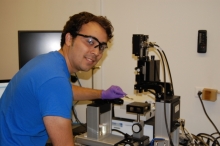
Major:
University:
Mentor(s):
Faculty Sponsor(s):
Faculty Sponsor's Department(s):
Project Title:
Project Description:
Controlling the surface wettability is appealing for many different industries, such as optics, textile, computer/tablet/phone, and solar panel industries. Unfortunately, wetting phenomena on even the simplest surfaces is still not fully understood. For instance, atomically smooth and clean silica is known to be hydrophilic (i.e. contact angle of water-air-silica is ~0, zero). However, if silica is left at room conditions for few hours or days, its hydrophilicity decreases (i.e. contact angle increases). Our hypothesis is that contaminants adsorbs onto the silica surface with time, which renders it hydrophobic. To test this hypothesis, a smooth and cleaned silica was stored (1) in vacuum (0.1 bar) inside a laminar hood (clean air) or (2) at room conditions. Then the contact angle of water, surface element analysis (using x-ray photoelectron spectroscopy - XPS) and surface topography (using atomic force microscopy - AFM) were measured at different times (up to 7 days). AFM results indeed confirm the formation of contamination layer of about 0.6 nm thick, even in clean air. XPS results suggest that the contamination layer is presumably comprised of hydrocarbons. Surprisingly, however, the layer forms within the first 20 minutes after cleaning the sample, whereas the contact angle increases only after several hours. To explain this discrepancy, our proposed mechanism is that initially (first few hours) the contaminants (molecules) adhere to the silica weakly, thus water can dissolve them and expose the clean, hydrophilic silica. With time, however, these contaminants rearrange and bind much more strongly to the silica surface, thereby preventing water from dissolving them. This case study is part of series of studies that will help us to understand the wetting behavior (contact angle, roll-off angle and contact angle hysteresis) on hydrophilic surfaces.
